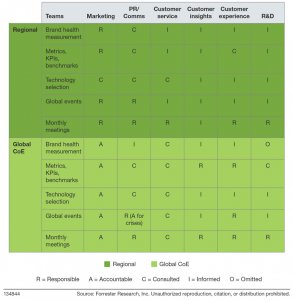Social media is human. It’s embedded in local cultural context of consumer needs, affinities, and behaviors. But to serve consumers, multinational companies need effective social intelligence to keep a finger on the global pulse of brands and simultaneously inspire local-relevant campaign content and interaction. So how do you start on this journey? My colleague Samantha Ngo and I have recently published a report that provides practical guidance on executing on this tender global / local balance. A summary of our take:
You need a Center of Excellence (COE). A center of excellence’s mandate is to drive common approaches and processes that enable generating insights from the data and assessing results across brands and regions. But a center of excellence isn’t a one-time a project that you can check off your company’s digital transition list. It’s a long-term commitment to establishing purpose, people, processes, and platforms that enable data- and insights-sharing across departments. Our research shows that the success factors for building an effective COE for social intelligence require you to:
1. Use a three-phased approach. If your firm is like most global, multibrand organizations, social listening began as a “project” for each brand (phase 1). Each brand team owned the relationship with their vendor, tracked the brand’s reputation, and used social data in the way they knew how. The most successful companies began to share insights by creating regional COEs (phase 2) before, over time, rolling them up into a global, cross-brand COE (phase 3).
2. Follow the 4P’s. You’ve set up social intelligence using the 4P’s framework: purpose, people, process, and platform, in that order. Creating a global COE for social intelligence is no different. Determine your global objective, designate the people and the job responsibilities, design and prioritize accountability for effective governance, and then choose your technology.
3. Outline roles with a RACI chart (see figure below). It may seem simplistic, but having a visual representation of the team’s roles (both for regional brand and global COEs) helps the team with accountability. Your RACI chart will vary based on your organization’s objectives (do you focus social intelligence on global customer service vs. market research?) but the idea is to get the message out. Everyone is involved in social intelligence.




